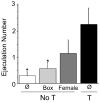Back to the future: The organizational-activational hypothesis adapted to puberty and adolescence
- PMID: 19446076
- PMCID: PMC2720102
- DOI: 10.1016/j.yhbeh.2009.03.010
Back to the future: The organizational-activational hypothesis adapted to puberty and adolescence
Abstract
Phoenix, Goy, Gerall, and Young first proposed in 1959 the organizational-activational hypothesis of hormone-driven sex differences in brain and behavior. The original hypothesis posited that exposure to steroid hormones early in development masculinizes and defeminizes neural circuits, programming behavioral responses to hormones in adulthood. This hypothesis has inspired a multitude of experiments demonstrating that the perinatal period is a time of maximal sensitivity to gonadal steroid hormones. However, recent work from our laboratory and others demonstrates that steroid-dependent organization of behavior also occurs during adolescence, prompting a reassessment of the developmental time-frame within which organizational effects are possible. In addition, we present evidence that adolescence is part of a single protracted postnatal sensitive period for steroid-dependent organization of male mating behavior that begins perinatally and ends in late adolescence. These findings are consistent with the original formulation of the organizational/activational hypothesis, but extend our notions of what constitutes "early" development considerably. Finally, we present evidence that female behaviors also undergo steroid-dependent organization during adolescence, and that social experience modulates steroid-dependent adolescent brain and behavioral development. The implications for human adolescent development are also discussed, especially with respect to how animal models can help to elucidate the factors underlying the association between pubertal timing and adult psychopathology in humans.
Figures





References
-
- Arnold AP, Breedlove SM. Organizational and activational effects of sex steroids on brain and behavior: a reanalysis. Horm Behav. 1985;19:469–98. - PubMed
-
- Baum MJ. Differentiation of coital behavior in mammals: a comparative analysis. Neurosci Biobehav Rev. 1979;3:265–284. - PubMed
-
- Biehl MC, et al. The influence of pubertal timing on alcohol use and heavy drinking trajectories. Journal of Youth and Adolescence. 2007;36:153–167.
-
- Bischof HJ, et al. Limitations of the sensitive period for sexual imprinting: neuroanatomical and behavioral experiments in the zebra finch (Taeniopygia guttata) Behavioural Brain Research. 2002;133:317–322. - PubMed
Publication types
MeSH terms
Substances
Grants and funding
LinkOut - more resources
Full Text Sources
Medical

